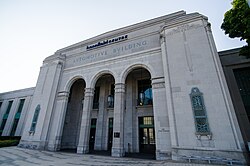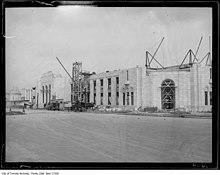
The Canadian National Exhibition (CNE), also known as The Exhibition or The Ex, is an annual event that takes place at Exhibition Place in Toronto, Ontario, Canada, on the third Friday of August leading up to and including Labour Day, the first Monday in September. With approximately 1.5 million visitors each year, the CNE is Canada's largest annual fair and the fifth largest in North America. The first Canadian National Exhibition took place in 1879, largely to promote agriculture and technology in Canada. Agriculturists, engineers, and scientists exhibited their discoveries and inventions at the CNE to showcase the work and talent of the nation. As Canada has grown as a country, the CNE has reflected the growth in diversity and innovation, though agriculture and technology remain a large part of the CNE. For many people in the Greater Toronto Area and the surrounding communities, the CNE is an annual family tradition.

Exhibition Place is a publicly owned mixed-use district in Toronto, Ontario, Canada, located by the shoreline of Lake Ontario, just west of downtown. The 197-acre (80 ha) site includes exhibit, trade, and banquet centres, theatre and music buildings, monuments, parkland, sports facilities, and a number of civic, provincial, and national historic sites. The district's facilities are used year-round for exhibitions, trade shows, public and private functions, and sporting events.

Canadian National Exhibition Stadium was a multi-purpose stadium in Toronto, Ontario, Canada, on the grounds of Exhibition Place. Originally built for Canadian National Exhibition events, the stadium served as the home of the Toronto Argonauts of the Canadian Football League (CFL) from 1959 to 1988, the Toronto Blue Jays of Major League Baseball (MLB) from 1977 to 1989, and the Toronto Blizzard of the North American Soccer League (NASL) from 1979 to 1983. The stadium hosted the Grey Cup game 12 times over a 24-year period.

The Paris Motor Show is a biennial auto show in Paris. Held during October, it is one of the most important auto shows, often with many new production automobile and concept car debuts. The show presently takes place in Paris expo Porte de Versailles. The Mondial is scheduled by the Organisation Internationale des Constructeurs d'Automobiles, which considers it a major international auto show.

The Canadian International Air Show (CIAS) is an annual air show in Toronto, Ontario, Canada. The show is an aeronautical display of military, government and civilian aircraft, primarily from Canada and the United States. The show takes place along Toronto's waterfront for three days during the Canadian Labour Day weekend. The show began in 1946 and has been held at Exhibition Place since 1949.

New Fort York, later the Stanley Barracks, is a former British and Canadian military base in Toronto, Ontario, Canada, located on the Lake Ontario shoreline. It was built in 1840–1841 to replace Toronto's original Fort York at the mouth of Garrison Creek as the primary military base for the settlement. Unlike the older fort, many of the new fort buildings were made with limestone instead of wood. A protective wall was planned for the new fort but was never built. The fort was used by the British army until 1870, and the Canadian military subsequently used the fort to train troops for the Second Boer War, World War I and World War II. It also trained one of the first regiments of the North-West Mounted Police. The Canadian military stopped using it after World War II and the fort was demolished in the 1950s. Only the Officers' Quarters building remains on the site.

The Reynolds-Alberta Museum is an agricultural, industrial, and transportation museum in Wetaskiwin, Alberta, Canada. The museum is situated on an 89-hectare (220-acre) property containing the main museum building, an aviation display hangar, and its storage facility.

The Autostadt is a visitor attraction adjacent to the Volkswagen factory in Wolfsburg, Germany, with a prime focus on automobiles. The complex was designed by Henn GmbH.

The Canadian Broadcasting Centre, also known as the CBC Toronto Broadcast Centre, is an office and studio complex located in Toronto, Ontario, Canada. It serves as the main broadcast and master control point for the Canadian Broadcasting Corporation's English-language television and radio services. It also contains studios for local and regional French-language productions and is the headquarters of the North American Broadcasters Association. Two floors of the facility house the ad agency Bensimon Byrne and its subsidiaries Narrative and OneMethod.

Coca-Cola Coliseum is an arena at Exhibition Place in Toronto, Ontario, Canada, used for agricultural displays, ice hockey, and trade shows. It was built for the Canadian National Exhibition (CNE) and the Royal Agricultural Winter Fair in 1921. Since 1997 it has been part of the Enercare Centre exhibition complex. It serves as the home arena of the Toronto Marlies ice hockey team, the American Hockey League farm team of the Toronto Maple Leafs. For the 2015 Pan American Games the venue hosted the gymnastics competitions and was known as the Toronto Coliseum.
Kate Aitken was a Canadian radio and television broadcaster in the 1930s, 1940s and 1950s. Sometimes known by the nickname Mrs. A, she was one of the most famous female broadcasters of her era. In addition, she was known as an expert on cooking; she gave many public talks and demonstrations, and her advice was relied upon by millions of homemakers.

The Petersen Automotive Museum is located on Wilshire Boulevard along Museum Row in the Miracle Mile neighborhood of Los Angeles. One of the world's largest automotive museums, the Petersen Automotive Museum is a nonprofit organization specializing in automobile history and related educational programs.

The Horse Palace is a heritage building at Exhibition Place in Toronto, Ontario, Canada, containing stables, a horse ring and various agencies. It was constructed to support the equestrian events of the Royal Agricultural Winter Fair. The ornamentation of the building is considered a fine example of Art Deco. It is a listed heritage building.

Enercare Centre, formerly known as the Direct Energy Centre and originally the National Trade Centre, is an exhibition complex located at Exhibition Place in Toronto, Ontario, Canada. It is used by the Canadian National Exhibition and the Royal Agricultural Winter Fair, as well as by various trade shows. In 2015, it hosted several sport competitions and the broadcasting centre for the 2015 Pan American Games.
The International Building, originally the Transportation Building, was an exhibition hall at Exhibition Place, Toronto, Ontario, Canada. In 1923, The Globe newspaper described it as "one of the most effective and beautiful display situations in the whole of the Exhibition buildings" after its opening. The building burnt down on August 23, 1974.

The Pure Food Building was a facility opened in 1922 on Exhibition Place at the Canadian National Exhibition (CNE) in Toronto, Ontario, Canada. It was demolished after the 1953 CNE to make way for the modernist Food Building, which still stands.

The Ontario Government Building, housing the Liberty Grand Entertainment Complex since 2001, is a heritage building located at Exhibition Place in Toronto, Ontario, Canada. Built in 1926 to provide exhibit space for the Government of Ontario during the annual Canadian National Exhibition (CNE), that function later moved to the Ontario Place complex. After a period of disuse, Toronto City Council approved a long-term lease with the Liberty Entertainment Group to use the building for private events.

The Horticulture Building, which houses the Toronto Event Centre, is a heritage building at Exhibition Place in Toronto, Ontario, Canada, containing event and conference space. It was built in 1907 for the display of horticulture during the annual Canadian National Exhibition (CNE), and it is a listed heritage building.

Hotel X Toronto is a hotel and sports club complex on the grounds of Exhibition Place in Toronto, Ontario, Canada. The hotel, part of the Library Hotel Collection, is intended to serve visitors attending conventions, meetings, and trade shows booked at the adjacent Enercare Centre and the Beanfield Centre. Hotel X Toronto is divided into three parts: the hotel tower, the Ten X Toronto (10XTO) athletic facility and the historic Stanley Barracks Officers' Quarters and foundations.
David Bednar is an American-born former theatre manager in Canada. He served as the general manager of the Canadian National Exhibition Association, which runs an annual fair called the Canadian National Exhibition (CNE). He retired in May 2015.























